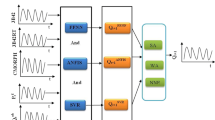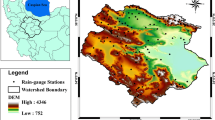Abstract
With the complex landform and climate in the Sichuan region, the need for practical and scientific research production by only utilising the rainfall data derived from ground stations or satellites has not been satisfied. To overcome this difficulty, rainfall data from 161 meteorological stations in 2016 are used in this study. According to the distribution of stations, 146 rainfall data from 161 meteorological stations in 2016 are used for inverse distance weighted interpolation, and then, linear regression, weighted regression, and Kalman filter fusion and optimal interpolation method data fusion are performed with TRMM 3B42 satellite rainfall data, respectively. Then, 15 meteorological stations evenly distributed in the study area are selected for the accuracy test. The results show that compared with the measurement at ground stations, linear regression shows the best merging effect on rainfall data derived from ground stations and satellite rainfall estimates across the daily scale: the correlation coefficient is the most significantly improved (0.2–0.7) and the reduction in root-mean-square error (RMSE) is the largest. The method is applicable for use in Sichuan Province when merging rainfall data. At the monthly scale, the rainfall data processed by using the Kalman filter present the highest accuracy (0.72–0.84). At this scale, the Kalman filter is more suitable.









Similar content being viewed by others
Data availability
Due to the strict security requirements from the departments, some or all data, models, or code generated or used in the study are proprietary or confidential in nature and may only be provided with restrictions.
References
Adiguzel, F., Bozdogan Sert, E., Dinc, Y., Cetin, M., Gungor, S., Yuka, P., & Vural, E. (2022). Determining the relationships between climatic elements and thermal comfort and tourism activities using the tourism climate index for urban planning: A case study of Izmir Province. Theoretical and Applied Climatology, 147(3), 1105–1120. https://doi.org/10.1007/s00704-021-03874-9
Cao, K. (2018). Analysis and prediction of climate and water resources change in Sichuan Province. Water Conservancy and Hydropower in Northeast China, 36, 28–30.
Cetin, M. (2020). The changing of important factors in the landscape planning occur due to global climate change in temperature, rain and climate types: A case study of Mersin City. Turkish Journal of Agriculture-Food Science and Technology, 8(12), 2695–2701. https://doi.org/10.24925/turjaf.v8i12.2695-2701.3891
Cetin, M. (2019). The effect of urban planning on urban formations determining bioclimatic comfort area’s effect using satellite imagines on air quality: A case study of Bursa city. Air Quality, Atmosphere & Health, 12(10), 1237–1249. https://doi.org/10.1007/s11869-019-00742-4
Cheng, L. (2013). Assessment study of merged precipitation and multiple satellite precipitation products. Vol. master: Nanjing University of Information Engineering, 69.
Cui, Y., Ma, Y., Zhao, Z., Li, Y., Liu, W., & Shu, W. (2018). Research on data fusion algorithm and anti-collision algorithm based on internet of things. Future Generation Computer Systems, 85, 107–115. https://doi.org/10.1016/j.future.2018.03.016
Sun, F., Roderick, M. L., & Farquhar, G. D. (2018). Rainfall stationarity and climate change. Proceedings of the National Academy of Sciences, 115(10), 2305–2310. https://doi.org/10.1073/pnas.1705349115
Gu, J. X., Shi, C. X., & Pan, Y. (2018). Test of merging methods for multi-source observed precipitation products at high resolution over China. Acta Meteorologica Sinica, 76, 755–766.
Gulácsi, A., & Kovács, F. (2020). Sentinel-1-imagery-based high-resolution water cover detection on wetlands, aided by Google Earth Engine. Remote Sensing (basel, Switzerland), 12, 1614. https://doi.org/10.3390/rs12101614
Guo, R. F., & Liu, Y. B. (2018). Strategy and method for satellite precipitation data evaluation: An overview. Remote sensing technology and Application, 33, 983–93. http://www.rsta.ac.cn/EN/10.11873/j.issn.1004-0323.2018.6.0983
Guzinski, R., Nieto, H., Sandholt, I., & Karamitilios, G. (2020). Modelling high-resolution actual evapotranspiration through Sentinel-2 and Sentinel-3 data fusion. Remote Sens.-Basel, 12, 1433. https://doi.org/10.3390/rs12091433
Hu, Q. F. (2013). Rainfall spatial estimation using multi-source information and its hydrological application. Vol. doctor: Tsinghua University, 157.
Hu, T., Li, Y., Li, Y., Wu, Y., & Zhang, D. (2020). Retrieval of sea surface wind fields using multi-source remote sensing data. Remote Sensing (basel, Switzerland), 12, 1482. https://doi.org/10.3390/rs12091482
Hong, S., Jang, H., Kim, N., & Sohn, H. (2015). Water area extraction using RADARSAT SAR imagery combined with Landsat imagery and terrain information. Sensors-Basel, 15, 6652–6667. https://doi.org/10.3390/s150306652
Huang, X. Y., Chen, Y., & Xiong, Y. (2009). Merging radar and rain gauge data using Kriging with external drift(KED) for quantitative precipitation estimation. Acta Meteorologica Sinica, 67, 288–297.
Jurczyk, A., Szturc, J., Otop, I., Ośródka, K., & Struzik, P. (2020). Quality-based compositing of weather radar derived precipitation. Meteorological Applications, 27, e1812. https://doi.org/10.1002/met.1812
Jiang, C., Qiu, H., Gao, L., Wang, D., Yang, Z., & Chen, L. (2020). Real-time estimation error-guided active learning Kriging method for time-dependent reliability analysis. Applied Mathematical Modelling, 77, 82–98. https://doi.org/10.1016/j.apm.2019.06.035
Li, W., Fan, R., & Jia, P. (2019). Sequence stratigraphy and lithofacies paleogeography of Middle-Upper Cambrian Xixiangchi Group in Sichuan Basin and its adjacent area, SW China. Petroleum Exploration and Development, 46, 226–240. https://doi.org/10.1016/S1876-3804(19)60005-4
Li, Z. (2015). A study of substitutability of TRMM remote sensing precipitation for gauge ased observation in Ganjiang River basinx. Advances in Water Science, 26, 983–993.
Ling, C., Lu, Z., & Zhu, X. (2019). Efficient methods by active learning Kriging coupled with variance reduction based sampling methods for time-dependent failure probability. Reliab. Eng. Syst. Safe, 188, 23–35. https://doi.org/10.1016/j.ress.2019.03.004
Liu, S. (2017). Precipitation data fusion and its application in hydrological simulation of TRMM satellite and ground rainfall network. Vol. master: WuHan University, 60.
Liu, S., Yan, D., Qin, T., Weng, B., & Li, M. (2016). Correction of TRMM 3B42V7 based on linear regression models over China. Adv. Meteorol, 2016, 1–13. https://doi.org/10.1155/2016/3103749
Liu, X., Liu, F. M., Wang, X. X., Li, X. D., Fan, Y. Y., Cai, S. X., & Ao, T. Q. (2017). Combining rainfall data from rain gauges and TRMM in hydrological modelling of Laotian data-sparse basins. Applied Water Science, 7, 1487–1496.
Machado, P. L., Oliveira, R. M. S. D., Souza, W. C. B., Araújo, R. C. F., Tostes, M. E. L., & Gonçalves, C. (2011). An automatic methodology for obtaining optimum shape factors for the radial point interpolation method. Journal of Microwaves, Optoelectronics and Electromagnetic Applications, 10, 389–401. https://doi.org/10.1590/S2179-10742011000200009
Nada, D., Bousbia-Salah, M., & Bettayeb, M. (2018). Multi-sensor data fusion for wheelchair position estimation with unscented Kalman filter. International Journal of Automation and Computing, 15, 207–217. https://doi.org/10.1007/s11633-017-1065-z
Pan, Y., Gu, J., Yu, J., Shen, Y., Shi, C., & Zhou, Z. (2018). Test of merging methods for multi-source observed precipitation products at high resolution over China. Acta Meteorologica Sinica, 76, 755–766.
Pan, Y., Shen, Y., Yu, J. J., & Zhao, P. (2012). Analysis of the ombined gauge-satellite hourly precipitation over China basedon the OI technique. Acta Meteorologica Sinica, 70, 1381–1389.
Pan, Y., Shen, Y., Yu, J., & Xiong, A. (2015). An experiment of high-resolution gauge-radar-satellite combined precipitation retrieval based on the Bayesian merging method. Acta Meteorologica Sinica, 73(1), 177–186.
Qian, X., Wang, S., Li, C., & Wang, G. (2019). Multi channels data fusion algorithm on quantum genetic algorithm for sealed relays. Journal of Physics. Conference Series, 1237, 22130.
Sharma, S., Chen, Y., Zhou, X., Yang, K., Li, X., Niu, X., Hu, X., & Khadka, N. (2020). Evaluation of GPM-Era satellite precipitation products on the southern slopes of the central Himalayas against rain gauge data. Remote Sensing (basel, Switzerland), 12, 1836. https://doi.org/10.3390/rs12111836
Sun, W., Wang, J., Zhang, J., Ma, Y., Meng, J., Yang, L., & Miao, J. (2018). A new global gridded sea surface temperature product constructed from infrared and microwave radiometer data using the optimum interpolation method. Acta Oceanologica Sinica, 37, 41–49. https://doi.org/10.1007/s13131-018-1206-4
Wang, Y., Xie, X., Meng, S., Wu, D., Chen, Y., Jiang, F., & Zhu, B. (2020). Magnitude agreement, occurrence consistency, and elevation dependency of satellite-based precipitation products over the Tibetan Plateau. Remote Sensing (basel, Switzerland), 12, 1750. https://doi.org/10.3390/rs12111750
Wang, Z. H. (2001). A brief introduction to TRMM precipitation radar and a summarry on the study of its application. Acta Meteorologica Sinica, 491–500.
Wu, J. F., Lin, S. Z., Li, W., & Zhang, F. T. (2018). Evaluation of TRMM 3B42 satellite precipitation data accuracy of Guizhou Plateau. Journal of China Hydrology, 38, 87–91.
Wu, J. J. (2019). Study on urban precipitation data fusion method based on improved geographical weighted regression Kriging Model. Vol. master: Zhengzhou University, 77.
Wei, S., Cui, C. F., & Tong, S. L. (2017). Meteorological satellite precipitation data accuracy test on time scale. Water Saving Irrigation, 55–8, 62.
Xiao, L. M., Qu, J. K., & Qi, H. S. (2018). A new fuzzy Kalman filter data fusion algorithm. Command Control and Simulation, 40, 60–63.
Xu, W. X. (2019). Research on data fusion aalgorithm based on fuzzy mathematics and principal component analysis. Advances in Applied Math, 08, 953–7. https://doi.org/10.12677/AAM.2019.85108
Yan, Q., Zhang, J., Meng, J., Wang, J., & Fan, C. (2017). Use of an optimum interpolation method to construct a high-resolution global ocean surface vector wind dataset from active scatterometers and passive radiometers. International Journal of Remote Sensing, 38, 5569–5591. https://doi.org/10.1080/01431161.2017.1341665
Zeren Cetin, I., Ozel, H. B., & Varol, T. (2020). Integrating of settlement area in urban and forest area of Bartin with climatic condition decision for managements. Air Quality, Atmosphere & Health, 13(8), 1013–1022. https://doi.org/10.1007/s11869-020-00871-1
Zhang, B., & Li, G. P. (2015). Night precipitation variation in Sichuan under global warming. Chinese Scientific Papers, 10, 1111–1116.
Zhao, H. Y., Liu, J., & Zhang, Z. J. (2016). Linear fusion for target detection in passive multistatic radar. Signal Processing, 130, 175–182. https://doi.org/10.1016/j.sigpro.2016.06.024
Zhou, Y. Q., Xue, H. R., Jiang, X. H., Wang, S. Y., & Wang, J. (2018). Meteorological data fusion based on proposed Kalman filter method. Application of Computer System, 27, 184–189.
Acknowledgements
The writers thank editors and reviewers for their valuable comments and suggestions.
Funding
This study is funded by Yangtze River Collaborative Fund for Hydro-sciences, Natural National Science Foundation of China (SFC) (U2040210), and Study on Flood Control Calculation of Three Gorges Reservoir Based on Meteorological-Hydrological-Hydrodynamic Coupling Numerical Model (51909010).
Author information
Authors and Affiliations
Corresponding author
Ethics declarations
Conflict of interest
The authors declare no competing interests.
Additional information
Publisher's Note
Springer Nature remains neutral with regard to jurisdictional claims in published maps and institutional affiliations.
Rights and permissions
About this article
Cite this article
Duan, Z., Ren, Y., Liu, X. et al. A comprehensive comparison of data fusion approaches to multi-source precipitation observations: a case study in Sichuan province, China. Environ Monit Assess 194, 422 (2022). https://doi.org/10.1007/s10661-022-10098-5
Received:
Accepted:
Published:
DOI: https://doi.org/10.1007/s10661-022-10098-5




